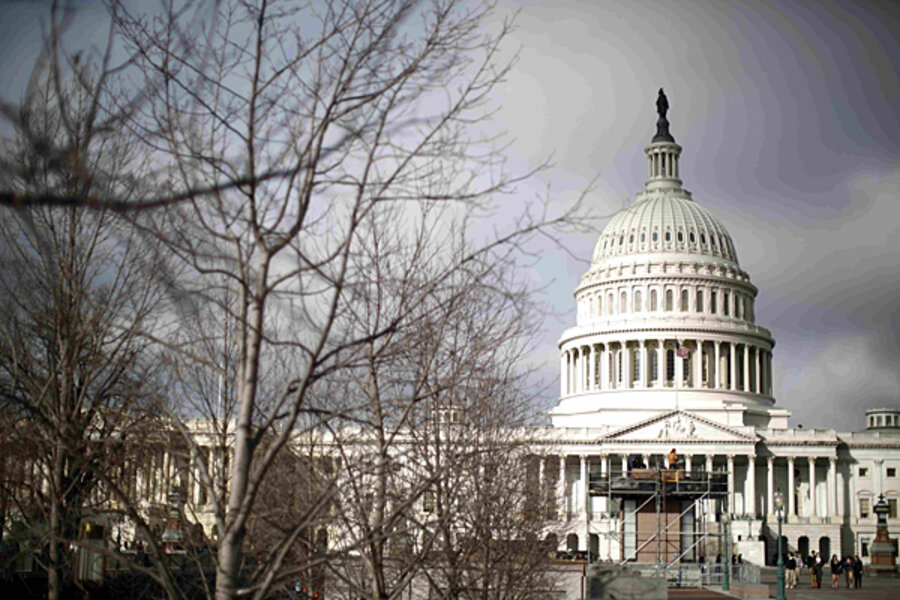The invisible sequester
Loading...
So far, the much-dreaded “sequester” – some $85 billion in federal spending cuts between March and September 30 – hasn’t been evident to most Americans.
The dire warnings that had issued from the White beforehand – threatening that Social Security checks would be delayed, airport security checks would be clogged, and other federal facilities closed – seem to have been overblown.
Sure, March’s employment report was a big disappointment. But it’s hard to see any direct connection between those poor job numbers and the sequester. The government has been shedding jobs for years. Most of the losses in March were from the Postal Service.
Take a closer look, though, and Americans are starting to feel the pain. They just don’t know it yet.
That’s because so much of what the government does affects the nation in local, decentralized ways. Federal funds find their way to community housing authorities, state unemployment offices, local school districts, private universities, and companies. So it’s hard for most Americans to know the sequester is responsible for the lost funding, lost jobs, or just plain inconvenience.
A tiny sampling: Brandeis University in Waltham, Massachusetts is bracing for a cut of about $51 million in its $685 million of annual federal research grants and contracts. The public schools of Syracuse, New York, will lose over $1 million. The housing authority of Joliet, Illinois, will take a hit of nearly $900,000. Northrop Grumman Information Systems just issued layoff notices to 26 employees at its plant in Lawton, Oklahoma. Unemployment benefits are being cut in Pennsylvania and Utah.
The cuts — and thousands like them — are so particular and localized they don’t feel as if they’re the result of a change in national policy.
It’s just like what happened with the big federal stimulus of 2009 and 2010, but in reverse. Then, money flowed out to so many different places and institutions that most Americans weren’t aware of the stimulus program as a whole.
A second reason the sequester hasn’t been visible is a large share of the cuts are in programs directed at the poor – and America’s poor are often invisible.
For example, the Salt Lake Community Action Program recently closed a food pantry in Murray, Utah, serving more than 1,000 needy people every month. The Southeast Alaska Regional Health Consortium is closing a center that gives alcohol and drug treatment to Native Alaskans.
Some 1,700 poor families in and around Sacramento, California are likely to lose housing vouchers that pay part of their rents. More than 180 students are likely to be dropped from a Head Start program run by the Cincinnati-Hamilton County (Ohio) Community Action Agency.
Most Americans don’t know about these and other cuts because the poor live in different places than the middle class and wealthy. Poverty has become ever more concentrated geographically.
A third reason the sequester is invisible is many people whose jobs are affected by it are being “furloughed” rather than fired. “Furlough” is a euphemism for working shorter workweeks and taking pay cuts.
Two thousand civilian employees at the Army Research Lab in Maryland will be subject to one-day-per-week furloughs starting on April 22, for example, resulting in a 20 percent drop in pay. The Hancock Field Air National Guard Base is furloughing 280 workers. Many federal courts are now closed on Fridays.
Furloughs spread the pain. The hardship isn’t as evident as it would be if it came in the form of mass layoffs. But don’t fool yourself: A 20 percent pay cut is a huge burden for those who have to endure it.
Bear in mind, finally, the sequester is just starting. The sheer scale of it is guaranteed to make it far more apparent in coming months.
Some 140,000 low-income families will lose their housing vouchers, for example. Entire communities that depend mainly on defense-related industries or facilities will take major hits.
If you thought March’s job numbers were disappointing, just wait.
With the sequester, America has adopted austerity economics. Yet austerity economics is the wrong medicine at exactly the wrong time. Look what it’s done to Europe.






